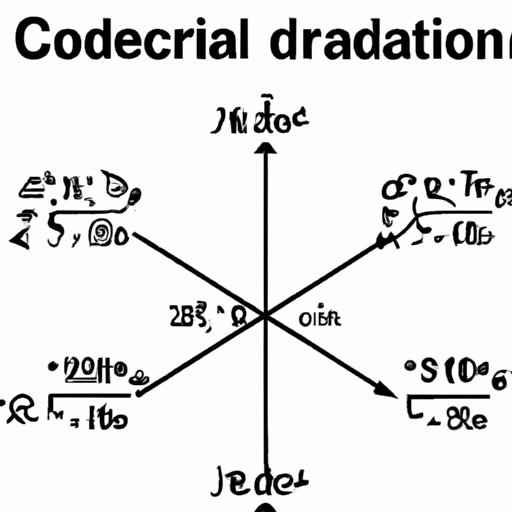I. Introduction
Mathematics is full of different units of measurement that are used to calculate a wide variety of things. Two of these units of measurement are degrees and radians, which are used to measure angles. In this article, we will explore the conversion process from degrees to radians in a step-by-step guide. By the end of this article, you will have a solid understanding of the why and how of converting degrees to radians.
II. Understanding Degrees and Radians
Before we dive into the conversion process, it is important to understand what degrees and radians are and their differences. A degree is a unit of measurement for angles, where one degree is equal to 1/360th of a full circle (360 degrees in total). A radian is also a unit of measurement for angles, but it is based on the radius of a circle. One radian is equal to the angle swept out by an arc that is equal in length to the radius of the circle.
III. Converting Degrees to Radians
Now that we know what degrees and radians are, we can move onto the conversion process. In many cases, it is necessary to convert between degrees and radians when working with geometry or trigonometry problems. The reason for this is that different formulas and calculations require the input to be in radians instead of degrees.
There are a few different formulas for converting degrees to radians, but the most common one is:
Radians = Degrees x π/180
For example, if we want to convert 45 degrees to radians, we would plug 45 into the formula:
Radians = 45 x π/180
Radians ≈ 0.7854
IV. Converting Radians to Degrees
Converting radians to degrees follows a similar formula. In order to convert radians to degrees, we can use the following formula:
Degrees = Radians x 180/π
For example, let’s say we have an angle of 2.5 radians. We can convert this to degrees by plugging it into the formula:
Degrees = 2.5 x 180/π
Degrees ≈ 143.24
V. Real-World Examples
Now that we have a good handle on converting degrees to radians and vice versa, we can explore some real-world examples of how these units of measurement are used in mathematics. One example comes from calculus, where radians are used to simplify trigonometric functions, making it easier to solve complex equations. Another example comes from computer graphics, where radians are used to rotate objects on screen.
VI. Making the Conversion Process Easier
Although the conversion process may seem daunting at first, there are a few shortcuts and tips that can make it easier to convert between degrees and radians. For example, memorizing a few key degrees-to-radians conversions can help speed up the process. Here are a few examples:
- 90 degrees ≈ π/2 radians
- 180 degrees ≈ π radians
- 270 degrees ≈ 3π/2 radians
Additionally, practice is key when it comes to mastering the conversion process. It can be helpful to work through a variety of different examples and problems in order to get comfortable converting between degrees and radians.
VII. Conclusion
Converting degrees to radians is an important skill in mathematics, and understanding how and why to do it is key. By following the steps in this article, and utilizing the shortcuts and tips provided, you can master the conversion process and feel confident in your ability to work with both units of measurement.
